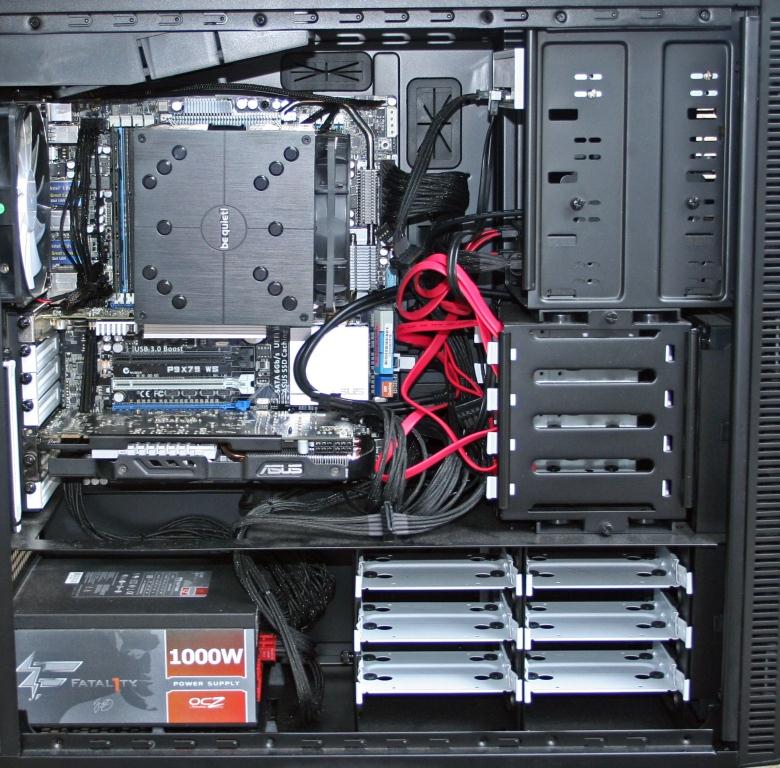TESTING METHODOLOGY
For testing of the Nytro MegaRAID 8120-4i, we’ll be using one of our enterprise testing rigs.
Testing the Nytro is slightly different than testing other solid state storage devices. That’s because it’s not, strictly speaking, a SSD. There are two SSDs on it, but we have to test them indirectly.
In some circumstances, we pre-cache the test files from the hard disks, while in others, we start with an empty cache and let the Nytro MegaRAID card cache as it goes.
The majority of testing is performed in Windows Server 2012, primarily using IOmeter 2010. Using 2010 allows us to test with both compressible, repeating data and random, incompressible data.
A special thanks to Asus, Crucial, OCZ, and Fractal Design for sponsoring our Enterprise Test Bench.
RAID PERFORMANCE
As we mentioned, the LSI Nytro MegaRAID is built upon on a Gen 3 LSI RAID card with 1GB of DDR3 cache. There are 8 ports going to the RoC. Two of those are “hardwired” to the cache devices, while four are available to SATA or SAS drives through the SFF-8087 port, hence the “4i” nomenclature. With 24 gigabits of throughput (minus overhead, of course) available for drives, just four ports shouldn’t hinder hard disk performance much, even lots of them. It’s not difficult to saturate sequential throughput with HDDs (which are great at larger sequential transfers), but when you’re only getting a few hundred IOPS per disk, saturating with small random IOs is nigh impossible. Naturally, you can’t cache SSDs with the MLC cache drives, nor would you want to. In order for caching to work, the cache has to be much, much faster than the devices being cached. The phrase “orders of magnitude” comes to mind.
To effectively cache MLC flash, you need fast RAM. To cache HDDs, you need NAND flash. And while no NMR8xxx-4i will ever be graced with SSDs, we can get a rough idea what a Gen 3 LSI RAID product can do if we slap a quartet of our trusty Crucial M4s on that 4i port. Let’s take four 256GB M4s and create a RAID 0 virtual drive.
With a sequential read using 256K transfers, we peak at 2257MB/s, with dips into the 1900MB/s range using IOmeter. The implication here is that we’d be able to reach roughly twice that with 8xM4s on an 8i product. Touching back on our quick look at JBOD performance with LSI’s 9207-8i HBA, 4200MB/s was the limit in terms of throughput over the 8x Gen 3 PCIe link. In terms of raw bandwidth, we should easily be able to hit that with 2x the ports and drives as the Nytro.
Since we’re running a few quick tests anyway, here’s some 4K random read performance numbers. A single M4 does 192MB/s all by it’s lonesome self, so we’re getting just a tad less than 4x the performance at 4K random reads. But this is really just short look at the SAS2208, so we don’t want to get too bogged down here with details. The takeaway is that even with just a 4i connection, HDDs, even large quantities of them, shouldn’t be hindered in appreciable manner. There should be enough bandwidth to go around, for both the drives on the 4i and the two cache SSDs.  For the LSI Nytro MegaRAID, we need the right tools. In this case, the right tools are mechanical drives with spinning disks and moving heads, not solid state storage. You couldn’t even try caching SSDs with SSD if you wanted too, much less make it any sort of effective. We need hard drives. LSI is keen to point out that their Nytro solution doesn’t need the fastest HDDs in the world. Garden variety SATA drives are accelerated just the same as high end SAS HDDs, but where’s the fun in that?
For the LSI Nytro MegaRAID, we need the right tools. In this case, the right tools are mechanical drives with spinning disks and moving heads, not solid state storage. You couldn’t even try caching SSDs with SSD if you wanted too, much less make it any sort of effective. We need hard drives. LSI is keen to point out that their Nytro solution doesn’t need the fastest HDDs in the world. Garden variety SATA drives are accelerated just the same as high end SAS HDDs, but where’s the fun in that?
 The SSD Review The Worlds Dedicated SSD Education and Review Resource |
The SSD Review The Worlds Dedicated SSD Education and Review Resource | 

Just, WOW !
Another amazing review! Keep up the hard work. I’ve continued to be impressed by the rich content on this site.
Great looking piece from LSI and nice review Chris! What gets me though is the price of the unit. When you consider you can plug a SSD into a 9270 with CacheCade for a considrably cheaper end piece that 1 extra port gained for having onboard nand just doesn’t make fiscal sence.
What would be exciting would be to see the nitro’s flash set to 4 x X Gb units set in R0 nativly, (just like you can already using CacheCade and SSDs without the loss of more ports).
It’s great to see LSI developing their Pcie.3 offering and I look forward to where they take it in the future.